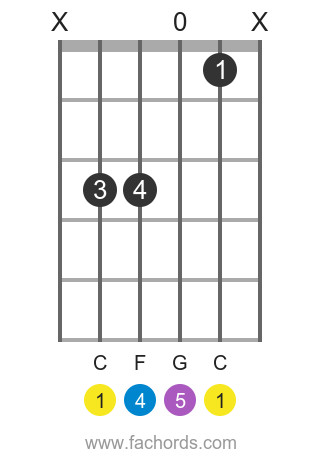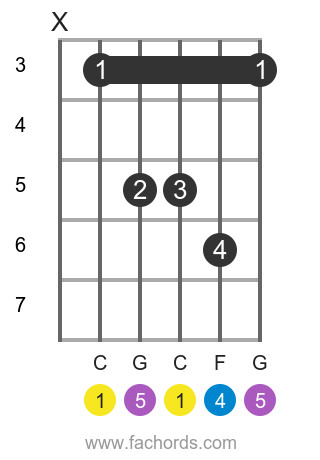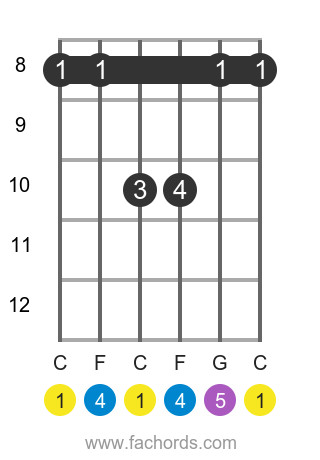Welcome to your comprehensive guide to the Csus4 guitar chord, a versatile and evocative chord that will add depth to your playing. If you’re looking to expand your chord vocabulary beyond basic major and minor chords, understanding suspended chords like the Csus4 is a fantastic next step.
This lesson will break down everything you need to know about the Csus4 chord, from its musical theory to practical finger positions on the guitar. We’ll explore:
- What is a Csus4 Chord? Understanding its unique construction and sound.
- Csus4 Chord Theory: Delving into the notes, intervals, and formula behind this chord.
- Easy Ways to Play Csus4: Mastering three essential positions for playing Csus4 across the fretboard.
- Using Csus4 in Music: Discovering how and where to use this chord to enhance your songs.
Let’s dive in and explore the world of suspended guitar chords with the Csus4!
Understanding the Csus4 Guitar Chord: Notes and Theory
The Csus4 chord, often written as C suspended 4th, gets its distinctive sound from its internal structure. Unlike major or minor chords which have a third, suspended chords, as the name suggests, “suspend” or omit the third. In the case of Csus4, the third of the C major scale (E) is replaced by the fourth (F).
Therefore, the notes in a Csus4 chord are C, F, and G.
- C – Root (1)
- F – Perfect Fourth (4)
- G – Perfect Fifth (5)
These notes are built using the intervals of Root, Perfect Fourth, and Perfect Fifth.
To understand this further, let’s look at the chord formula for a Suspended Fourth chord:
1 - 4 - 5This formula applies to all sus4 chords, not just Csus4. By replacing the 3rd with the 4th, we create a sound that is neither major nor minor, but has a unique open and unresolved quality. This suspension creates a musical tension that often resolves beautifully to a major or minor chord.
If you’re interested in learning more about how chords are constructed from intervals, we recommend checking out our detailed guide on building chords by stacking intervals. For a deeper dive into the concept of intervals themselves, our fretboard intervals tutorial will be highly beneficial.
How to Play the Csus4 Guitar Chord: Positions
Now, let’s get practical and explore how to play the Csus4 chord on your guitar. We’ll cover three essential positions, starting with the easiest open position.
Position 1: Open Csus4 Chord
This is the most common and easiest way to play the Csus4 chord, especially for beginners. It utilizes open strings and is a great starting point for mastering this chord.
 Open position Csus4 guitar chord diagram
Open position Csus4 guitar chord diagram
To play the open Csus4 chord:
- Index Finger (1st fret, B string): Place your index finger on the 1st fret of the B string (2nd string).
- Middle Finger (2nd fret, D string): Place your middle finger on the 2nd fret of the D string (4th string).
- Ring Finger (3rd fret, A string): Place your ring finger on the 3rd fret of the A string (5th string).
- Strum: Strum all strings except the low E string (6th string). Alternatively, you can strum all six strings, as the open low E string doesn’t clash harshly with the Csus4 chord.
This open position Csus4 is perfect for songs in the key of C, G, or F major.
Position 2: Barre Csus4 Chord (Movable Shape)
This position uses a barre chord shape, making it movable up and down the fretboard. This means you can play a sus4 chord with any root note using this shape.
 Barre position 2 Csus4 guitar chord diagram
Barre position 2 Csus4 guitar chord diagram
To play the Position 2 Csus4 chord:
- Barre with Index Finger (5th fret): Barre your index finger across all six strings at the 5th fret.
- Ring Finger (7th fret, A string): Place your ring finger on the 7th fret of the A string (5th string).
- Pinky Finger (7th fret, D string): Place your pinky finger on the 7th fret of the D string (4th string).
- Strum: Strum all six strings.
This shape is based on the open Asus4 chord shape barred up the neck. To play a Csus4, you barre at the 5th fret because the 5th fret on the low E string is the note C.
Position 3: Barre Csus4 Chord (Movable Shape)
This is another movable barre chord shape for Csus4, offering a different voicing and feel compared to Position 2.
 Barre position 3 Csus4 guitar chord diagram
Barre position 3 Csus4 guitar chord diagram
To play the Position 3 Csus4 chord:
- Barre with Index Finger (8th fret): Barre your index finger across five strings (from A to high E string) at the 8th fret.
- Middle Finger (9th fret, G string): Place your middle finger on the 9th fret of the G string (3rd string).
- Ring Finger (10th fret, B string): Place your ring finger on the 10th fret of the B string (2nd string).
- Strum: Strum from the A string (5th string) down to the high E string (1st string).
This shape is derived from a D shape barre chord and is moved up the neck. Barre at the 8th fret to create a C root.
For more chord positions and voicings, explore our extensive guitar chords library. If you’re finding barre chords challenging, our Bar Chords Tips tutorial can provide helpful guidance.
Using the Csus4 Chord in Music
The Csus4 chord is a commonly used chord in various musical genres, including:
- Pop: Often used to add a touch of sophistication and emotional depth to chord progressions.
- Rock: Found in both rhythm and lead guitar parts, adding a powerful and unresolved sound.
- Folk: Its open and airy quality makes it a great fit for folk and acoustic music.
- Indie: The unique sonic character of sus4 chords is embraced in indie and alternative music.
The Csus4 chord’s suspended nature creates a feeling of anticipation and often resolves nicely to a C major or C minor chord. Experiment with incorporating it into your songwriting and improvisations.
Further Exploration
Once you’re comfortable with the Csus4, you can explore other suspended chords. Here are a few to get you started:
To test your knowledge and identify chord shapes you see, try our interactive guitar chord reverse namer tool.
Conclusion
The Csus4 guitar chord is a valuable addition to any guitarist’s toolkit. Its unique sound and versatile applications make it a chord worth mastering. By understanding its theory and practicing these positions, you’ll be able to incorporate the Csus4 chord into your playing and songwriting, adding a new dimension to your musical expression. Keep practicing, and enjoy the suspended sounds of the Csus4!
